Proper cutting movements are one of the most under-taught skills in our youth programs.
A lot of the time coaches don’t worry about teaching proper cutting to their players, they say it will ‘come naturally’ with time. Well I’m here to tell you it won’t. At least not proper cutting. Cutting that will get your players open when ever they wish during a game.
Players need to learn how to get open on their own. They’re not always going to be able to use a screen to get them open for a pass. Sometimes they’re going to have to do it in isolation. That’s what we as coaches need to teach them how to do.
Players like Reggie Miller and Ray Allen can score 30 points a game without taking a single dribble just because they’ve mastered the art of reading the defense and then using the appropriate cut to get them open for the pass.
In this article I’m going to describe and show you the 10 most common cuts in basketball.
1. Backdoor Cut
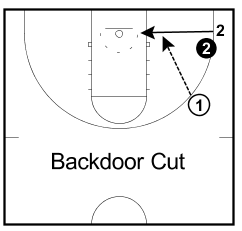 The backdoor cut is used when the defender is over-playing in the passing lane denying the pass. Depending on your offence, this will leave a big hole to cut into between. If you are being denied the pass you will be able to backdoor cut.
The backdoor cut is used when the defender is over-playing in the passing lane denying the pass. Depending on your offence, this will leave a big hole to cut into between. If you are being denied the pass you will be able to backdoor cut.
The biggest problem with backdoor cuts is that it requires great passing skills by the person with the ball to result in an easy lay-up. This is why it is not a common pass in youth basketball. The lack of passing skills results in many turnovers.
For the backdoor cut to be most effective your players must set their defender up and have a quick change-of-direction and explode towards the basket.
2. V-Cut
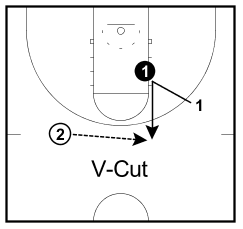 V-cuts are the most common type of cut and are mostly
V-cuts are the most common type of cut and are mostly
used when on the perimeter in isolation when you need to
get open for a pass.
V-cutting requires body-to-body contact by players. They are executed by walking the defender a couple of feet inside the 3-point line, planting your foot, and then exploding out to receive the ball.
It works because the defense’s reaction time won’t be quick enough to stop the player from receiving the pass.
3. L-Cut
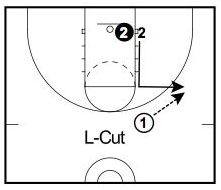 L-cuts are a great way to get open on the perimeter when starting on the block.
L-cuts are a great way to get open on the perimeter when starting on the block.
This cut doesn’t require the offensive player to be quick, rather this cut will be most effective if good footwork is used and good use of the body.
Take the defender up to the elbow, get your top foot over theirs, give a small nudge to create space, and lead directly out to the wing while calling for the ball.
4. Curl Cut
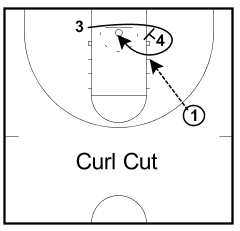 The curl cut is executing a curl around a screen.
The curl cut is executing a curl around a screen.
This cut relies on the offensive player reading his defender. If the defense follows around the screen, then a curl cut is the best option to receive an open lay-up. But if the defense cheats on the screen and goes over it, then the best cut would be the next one on the list, the flare cut.
5. Flare Cut
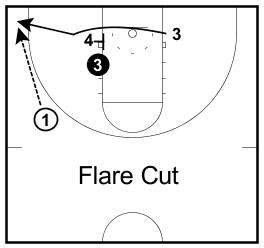 The curl cut and flare cut go hand-in-hand.
The curl cut and flare cut go hand-in-hand.
When the defender cheats on a curl and tries to cut it off, players should flare out to the corner.
6. Deep Cut
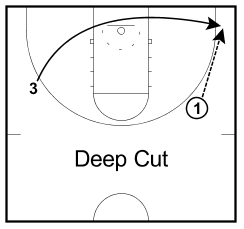
A deep cut involves the player on one side of the floor to cut baseline behind everyone and to the other side.
This cut is used a lot against zone defenses because often the defense doesn’t see the player cutting if they’re pre-occupied with the ball and other players.
7. UCLA Cut
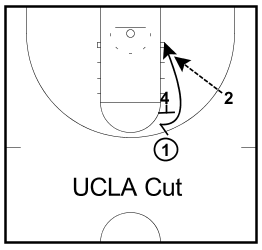 The UCLA cut got its name because it was popularized by UCLA legendary coach John Wooden.
The UCLA cut got its name because it was popularized by UCLA legendary coach John Wooden.
It involves a player at the top of the key making a pass to a perimeter player and then cutting directly to the block off a high post screen. If performed properly, this cut often leads to an open lay-up for the cutter.
8. Front Cut
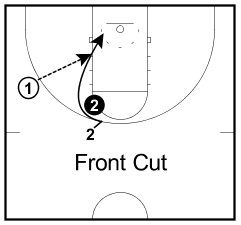
The front cut involves getting on the ball-side of your opponent.
Usually this is executed by performing a jab step or a small cut behind the defense to get them to move back. Once they do, you cut in front of them closest to the ball.
9. Shallow Cut
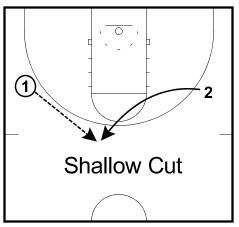 A shallow cut is used when you’re exchanging positions with the person dribbling the ball. This means going underneath them and keeping your defender occupied while they fill the spot that you were in.
A shallow cut is used when you’re exchanging positions with the person dribbling the ball. This means going underneath them and keeping your defender occupied while they fill the spot that you were in.
10. Flash Cut
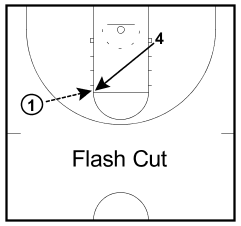 A flash cut is a quick, explosive cut made by a post player to the high post.
A flash cut is a quick, explosive cut made by a post player to the high post.
If you found this post useful, please do me a favor and share it!
– Coach Mac
